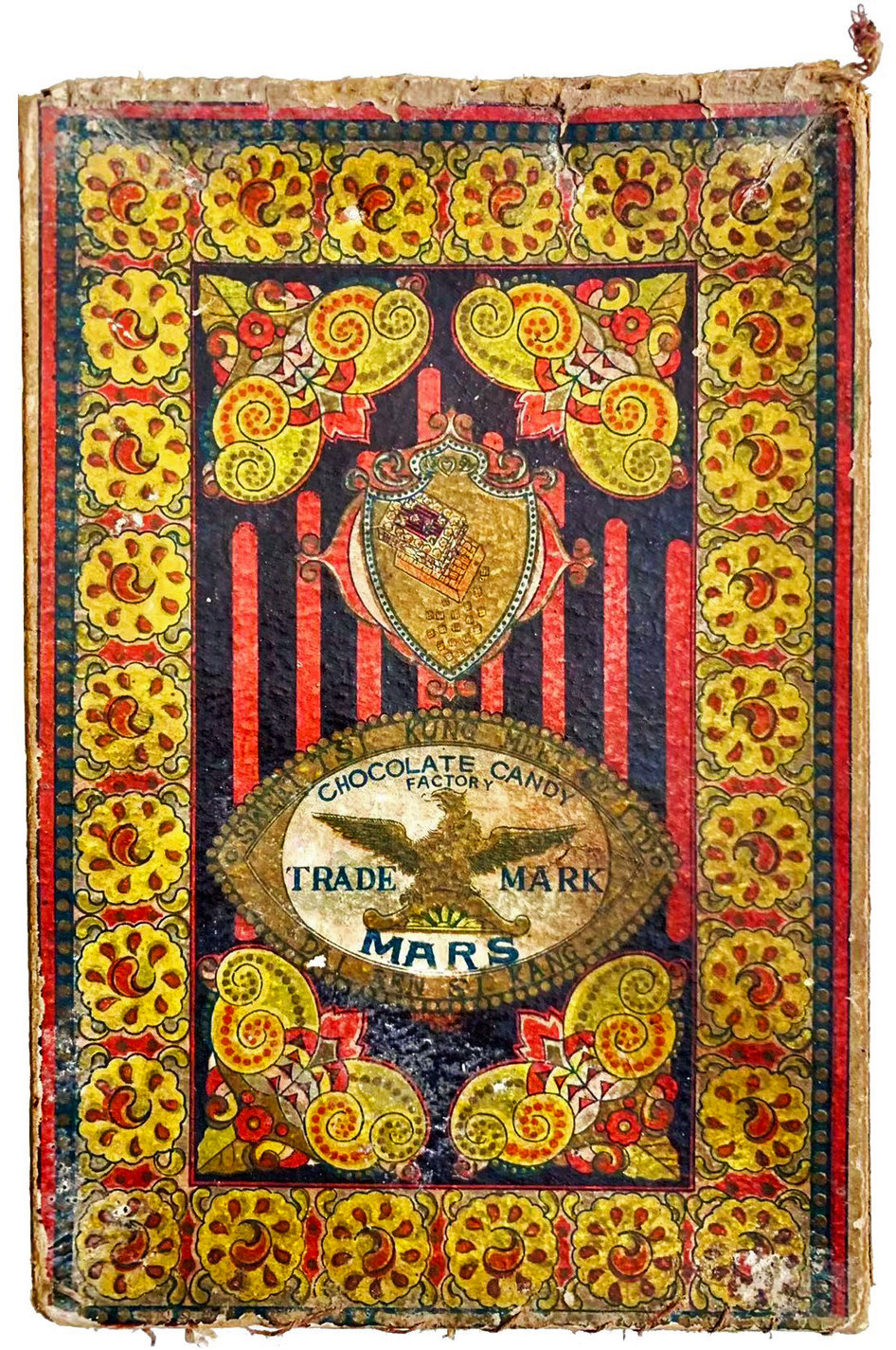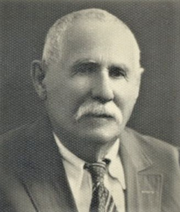
This exquisite chocolate box from our collection unveils the exceptional history of Russian-Jewish immigrants who from the 1920s to 1940s, built a vast chocolate production empire, spanning across four factories in four Chinese cities and operating seven outlet stores.

The Chinese Eastern Railway, constructed by the Russian Imperial Government from 1897 to 1902, provided a shortcut for the world's longest railroad, the Trans-Siberian Railway, from near the Siberian city of Chita, via Harbin to the Russian port of Vladivostok. Its southern branch connected Harbin with the coastal city the Russians called Dalniy, the Japanese Dairen and which today is known as Dalian in Chinese. The project attracted a large number of Russian workers and unlike Dalian, which was already a developed city, Harbin was built almost entirely from scratch by these early settlers. By 1913, Harbin had become an established Russian colony and in the 1920s was flooded with an additional 100,000 to 200,000 White émigrés fleeing from the Bolshevik Revolution.

The architecture of the story-book city in the Far Orient became reminiscent of Moscow or St. Petersburg, with onion-domed cupolas, empire-style façades, wide boulevards and touches of art nouveau.
Likewise, the Russians also brought their distinct food culture with them and delicacies like the many pastries, sourdough bread called “khleb,” smoked sausage, and borscht, which are still commonly eaten by the Chinese population of Harbin to this day.

The first Jew to settle in Harbin in 1899, was Grigory B. Drizin (also spelled Drisin) from Tobolsk. He had run a trading company since 1894 dealing with grain and livestock in Harbin. During the Russo-Japanese war of 1904 to 1905, he expanded his business endeavors and also built a flour mill. In 1923 the serial entrepreneur opened the Jewish People's Bank on the main thoroughfare of Harbin, the Kitayskaya Street (Chinese Street), which is today’s Central Street (中央大街).

His daughter Paya Grigorievna married another Jewish immigrant, Pinchas Leibovich Zukerman from Odessa, in the same year and in 1925 the couple established the Mars Chocolate & Candy factory at No. 111 Belgian Street, today called Bile Street (比乐街). Paya’s twin sons, Jack and Matthew from a previous marriage, started to work in the company early on as candy makers and in parallel with the factory the family also opened the Mars Café in the central location of No. 43-73 Kitayskaya Street, opposite the Russian-run Hotel “Moderne”.

The Chinese name of the company, the "Mars" Chocolate Confectionery Factory (“马尔斯”巧克力糖果点心厂), indicates that it was named after the Roman god Mars, rather than the planet, which unlike in English, is written differently in Chinese (火星). The world-famous American Mars Candy Factory on the other hand was started in 1911 in Tacoma, Washington by Franklin Clarence Mars but the venture initially failed. By 1920, Mars had returned to his home state, Minnesota, where the earliest incarnation of the present-day Mars company was founded that year as Mar-O-Bar Co., and it was only later formally incorporated there as Mars Inc. The Mars bar, which became its signature product was only launched in 1932 by Forrest Mars, Franks son in the United Kingdom.

It is therefore possible, that the Russian-owned Mars chocolate company in China, was not inspired in any way by the chocolate company in the USA of the same name. The American Mars was also not active in China until after World War II. Either way, the Mars Café in Harbin initially had no more than 70 square meters and only served hot beverages together with cakes, chocolates, confectioneries and snacks produced by its own factory.
After the Japanese invasion of Manchuria in September 1931, Harbin became part of the newly formed puppet state of Manchukuo. Around that time the Mars Café expanded to a full-blown restaurant serving Russian dishes. With its 80 tables it was able to serve up to 400 guests at a time until 1am every day. Apparently, it employed over 40 Russian, Chinese and Japanese waiters and in fact became the largest Western-style restaurant in Harbin. At some point its manager was a German by the name of Rudolf Gabler (or Gaipler).

From a 1930s Russian-language advertisement we can learn that during that period, Mars opened three more stores for its confectioneries across Harbin, namely on Novotorgovaya Street “next to Tchurin's store”, on Sungari Pass corner of Pekinskaya Street and in Modiagou on Gogolevskaya Street No. 68.
But not only that: The advertisement also reveals that Mars furthermore established a second chocolate factory in the Manchukuoan capital of Mukden (today’s Shenyang) at No. 4 Ujimachi Street under the representation of Br. Uryan and a third factory in Dairen (now Dalian) at No. 206 Yamagata Dori Street, which was also part of Manchukuo.

A closer look at our chocolate box reveals that it was produced at that third Mars location in Dalian.
The box is beautifully illustrated with Russian floral ornaments reminiscent of folk designs in the Khokhloma style and features the Mars Chocolate Candy Factory’s distinct logo of an eagle surrounded by the inscription “SWEET TSI KUNG MEET CO. LTD - DAI REN SI KANG”. The latter referring to the Xigang district of Dalian.

Mars’ various factories not only produced chocolates, but many variations of confectioneries and candies. They were shipped in gorgeous tin boxes or packaged in beautifully colored wrappers and were available across northern China, popularizing the brand among foreigners and Chinese alike.
While Mars seems to have thrived, Jewish inhabitants of Manchukuo were increasingly threatened. Faced with anti-Semitism, political intimidation and the takeover of their businesses by the Japanese, over half of its Jewish population left, moving to other cities in China, notably the international settlements in Shanghai and Tianjin. By 1935, Harbin’s Jewish community had declined to 5,000, compared with 20,000 in the 1920s.

These developments and the outbreak of World War II seemed to have been the major drivers for P.L. Zukerman to establish a fourth chocolate factory in the International Settlement of Shanghai at 100 Great Western Road (today’s Yan’an West Road) in around 1940, as an entry in the 1941 Hong List directory reveals. One year later in 1941, another Jewish immigrant called Semyon Liberman left Harbin and partnered with Zukerman to open the Shanghai branch of the Mars Café on 147 - 149 Nanking Road (today’s Nanjing East Road). Born in 1893 in Sevastopol, in the Crimea, he had moved to Harbin in 1916 where he was offered a job as an accountant.

During the Japanese occupation of Shanghai stateless Russians and Jewish immigrants that had moved to China prior to the 1930s were not restricted, unlike the recent Jewish refugees which were confined to the Hongkou ghetto, or nationals of the Allied Powers, which were interned in camps. This allowed both the Shanghai Mars chocolate factory and the Mars Café at its prestigious Nanjing Road location to not only persevere but, in fact, flourish during the war years.
The Soviet army took Harbin from the Japanese in August 1945 and after the unconditional surrender of Japan in September 1945, also Dalian was passed back to the Soviets until in 1950 when the USSR presented the city to the Chinese Communist government without any compensation.

According to Chinese sources, the owners of the Mars Café & factory in Harbin closed the business in 1946 and moved to Shanghai. In 1948 the former Harbin Mars Café was briefly reopened as the “Friendship Hotel” and operated by a Chinese manager. In 1959, it was transformed into a state-owned enterprise after a public-private partnership.
Today it still exists as the popular Hua Mei Western Restaurant (华梅西餐厅) at the same location, now No. 112 Central Street (中央大街的中心112号), and continues to serves Russian dishes and beverages.

The Shanghai Mars restaurant and factory were still listed in the 1947 Shanghai Telephone Directory and even a third café location seemed to have been opened. Emigration records suggest that the Drisin-Zukermans continued to operate the business even after the Communist Liberation of Shanghai in 1949 and well into the 1950s.
Pinhas Leibovich Zukerman, the Mars founder and China’s “Chocolate Czar”, died on February 12th 1955 at age 71 in his Shanghai residence at Grosvenor House Apt. 1005. His father-in-law Grigory B. Drizin, had remained in Harbin until his death on January 18th 1949 at the old of 103 years. P.L.’s wife Paya Zukerman emigrated to Brazil in 1955 where her sons Matthew and Jack had already moved to in 1949 and 1954 respectively.

Like in Harbin, the café in Shanghai eventually went through nationalization, closure and reopening and today exists once again, although under a new name, "East Sea Coffee" (东海咖啡馆), and at a different address on 110 Dianchi Rd. In Chinese sources it is often wrongly claimed to have been opened in 1934, while it is confirmed by Semyon Liberman’s son, Yaacov Liberman, that the Shanghai Mars Café was only established in 1941.

In the interregnum period between the end of the war and the establishment of the People’s Republic of China, the American Mars Incorporated finally made its move into China and incorporated its famous trademarks such as Mars, Milky Way and Snickers there in 1946. It soon left the country again in 1949 but successfully re-entered the market in the 1990s. Today, Mars Inc. holds a stunning 34% share of China’s chocolate market, far ahead of Ferrero (22%), Nestle (8%), Hershey (4%) or Godiva (3%). However, the Russian chocolate and candy brand, which originally made the Mars name famous in China, has almost entirely been forgotten, except for a commemorative plaque at the Harbin Hua Mei Restaurant and the few rare artifacts in our museum.
P.S.: A big thank you to Katya Knyazeva who helped with the research and editing of this article!

























































































Write a comment